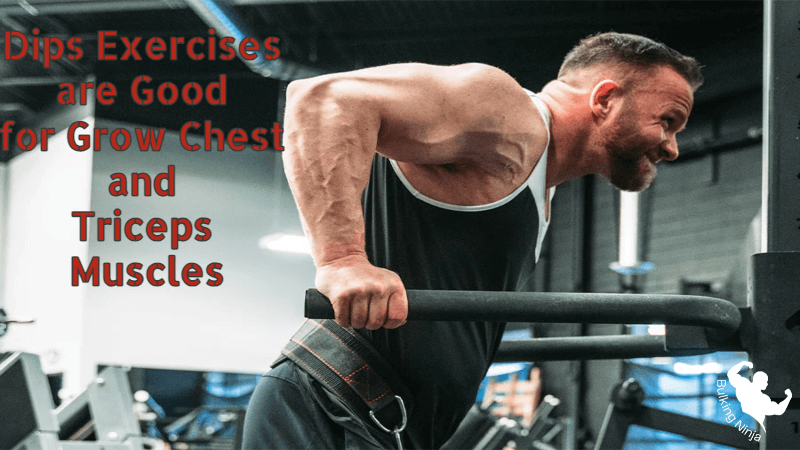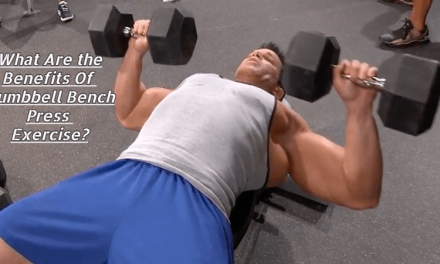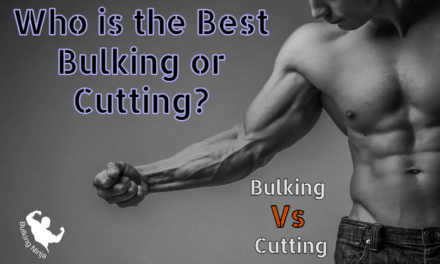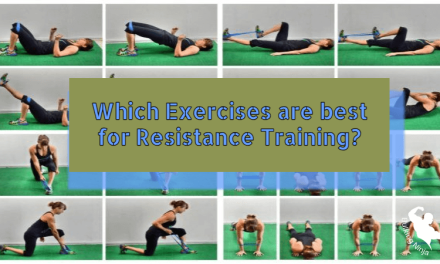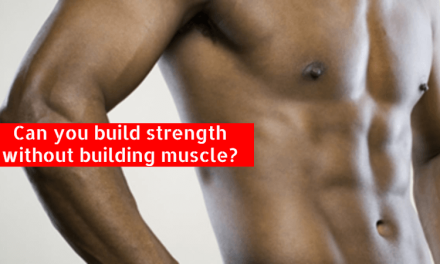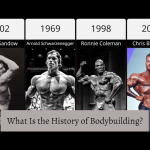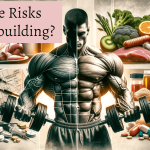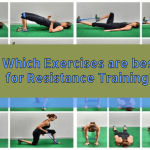If you’ve been on a quest to build a stronger, more defined upper body, you’ve likely explored various exercises and routines to target your chest and triceps.
While bench presses and push-ups might come to mind first, there’s another group of exercises that often goes overlooked but packs a powerful punch when it comes to muscle growth: dips. Dips are a versatile and highly effective compound exercise that can help you achieve a sculpted chest and bulging triceps.
In this blog post, we’re going to dive deep into the world of dip exercises, exploring dips exercises are good for grow chest and triceps muscles, their benefits, proper form, and how to incorporate them into your fitness routine to unlock your chest and triceps muscle-building potential. Whether you’re a seasoned gym-goer or just starting on your fitness journey, get ready to discover the incredible benefits of dips for your upper body development.
Table of Contents
Dips exercises are good for grow chest and triceps muscles
Dips exercises are a hidden gem in the world of strength training, and they’re particularly excellent for developing both your chest and triceps muscles. While many people gravitate toward bench presses and push-ups, dips offer a unique challenge and a whole array of benefits.
This often underrated compound movement engages multiple muscle groups simultaneously, making it a powerhouse for upper body development. In this blog post, we’ll unveil the secrets of dips, explaining how they stimulate muscle growth in your chest and triceps.
Whether you’re an experienced lifter looking to switch up your routine or a beginner eager to build a stronger upper body, you’re about to discover how dips can be your new best friend on your fitness journey. Let’s dive into the science and techniques behind this incredible exercise and unlock the potential for a more muscular chest and triceps.
How to do Dips?
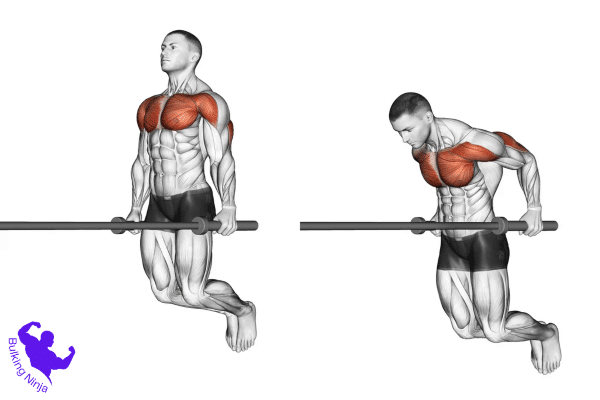
Dips exercises, often underestimated in the realm of strength training, are indeed a potent ally in your pursuit of a well-defined chest and robust triceps. These exercises engage key muscle groups, including the triceps, deltoids, pecs, and rhomboids. When you perform a bench dip or utilize parallel bars for tricep dips, you harness the potential for substantial muscle growth.
The magic lies in the fact that dips require you to lift your entire body weight, fostering both strength and endurance. And here’s the great news – even if you’re not yet capable of handling your full body weight, gyms offer machines that provide invaluable assistance. Incorporate dips into your routine 2-3 times a week, and you’ll be on your way to a stronger, more sculpted upper body.
Optimizing Your Strength Training Routine
In your quest for muscle growth in the chest and triceps, dips exercises stand out as a game-changer. These exercises not only target the desired muscle groups but also enhance overall upper body strength. By using your body weight as resistance, dips offer a unique challenge that encourages growth and definition.
Whether you’re a beginner or a seasoned fitness enthusiast, the versatility of dips caters to all levels. Don’t be discouraged if you can’t yet manage your full body weight – modern gym equipment is designed to provide the support you need. Incorporating dips into your weekly routine is a strategic move towards achieving your chest and triceps muscle-building goals.
How to Perform Dips Workout?
Dips are a compound exercise that primarily targets the triceps but also engage the chest and shoulders to some extent. Here’s how to perform dips:
Equipment Needed
- Parallel bars (usually found on a dip station or dip machine) or parallel handles on a pull-up/dip station.
Instructions
- Set up the Equipment
If you’re using a dip station, adjust the parallel bars to shoulder-width apart. Ensure they are stable and secure. Stand between the bars or handles, facing away from the equipment. - Grip
Grab the bars or handles with your palms facing down (pronated grip) and your arms fully extended. Your hands should be about shoulder-width apart. - Starting Position
Lift yourself up so your arms are straight, and your feet are off the ground. Your body should be vertical, and your elbows should be locked. - Lowering Phase
Lower your body by bending your elbows. Keep your torso upright and your shoulders back. Lower yourself until your upper arms are parallel to the ground or your chest is just above the bars, depending on your comfort level and strength. - Pushing Phase
Push through your palms to raise your body back up to the starting position. Straighten your arms fully but avoid locking your elbows to prevent unnecessary strain on the joint. - Repeat
Perform the desired number of repetitions. Start with a number that’s comfortable for your fitness level and gradually increase as you become stronger.
Tips for Proper Form
- Keep your body as upright as possible throughout the movement.
- Avoid excessive leaning forward or backward.
- Don’t rush; perform the exercise with controlled, deliberate movements.
- Breathe steadily; exhale as you push up and inhale as you lower yourself.
Dips can be challenging, so it’s essential to ensure you have the necessary upper body strength before attempting them. If you’re new to dips or working out in general, consider using assistance like a dip machine or resistance bands to make the exercise more manageable until you build the strength to do bodyweight dips. Always prioritize proper form to avoid injury.
What Muscles Do Dips Work?
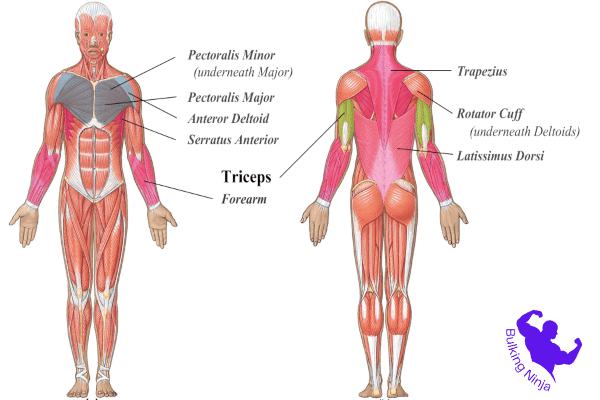
It’s essential to explore the various entities involved in this compound exercise. Dips primarily target the chest, triceps, and a host of supporting muscles.
- Dips Target Chest and Triceps
Dips are particularly effective in engaging the pectoralis major, the largest muscle in the chest, and the triceps brachii, the muscles at the back of your upper arm. These two entities are the primary focus of this exercise. - Assisting Muscles
To achieve the full range of motion during dips, the anterior deltoid, pectoralis minor, rhomboids, levator scapulae, and latissimus dorsi also come into play. These muscles support the target entities and contribute to the overall effectiveness of the exercise. - Stabilization and Support
- Muscles such as the teres major and trapezius are essential for stabilization during dips. They help maintain proper form and prevent unnecessary strain on the joints.
By understanding this comprehensive list of entities and their roles in dip exercises, individuals can tailor their workouts to target specific muscle groups effectively. Focusing on these entities and related aspects ensures a productive and efficient dip routine for enhanced muscular development and strength.
Benefits of Adding Dips to Your Workout?
Dips are a versatile and highly effective compound exercise that can provide numerous benefits when integrated into your workout regimen. Whether you’re a beginner or a seasoned fitness enthusiast, here are the key advantages of adding dips to your workout:
- Comprehensive Upper Body Engagement
Dips are renowned for their ability to engage multiple muscle groups simultaneously. By targeting the chest, triceps, shoulders, and even the back, dips offer a holistic upper body workout. This comprehensive engagement can help you achieve a well-balanced and sculpted physique.
- Strengthens the Chest and Triceps
Dips primarily focus on the pectoralis major and triceps brachii muscles. Regular incorporation of dips into your routine can lead to increased strength and muscle development in these areas. This, in turn, can enhance your performance in other upper body exercises.
- Supports Functional Strength
Dips are a functional exercise that mimics real-life movements, such as pushing yourself up from a surface or lifting your body weight. This functional strength can have practical applications in everyday activities and sports.
- Versatile and Accessible
Dips can be performed in various settings, from the gym to outdoor parks with dip bars. This versatility makes them accessible to individuals with different fitness levels and equipment availability.
- Enhanced Triceps Definition
For those aiming to achieve well-defined triceps, dips are a go-to exercise. They isolate and intensively work the triceps brachii, contributing to improved muscle definition.
- Improved Shoulder Stabilization
Dips engage the anterior deltoid, aiding in shoulder stabilization. Strong shoulders are crucial for overall upper body strength and injury prevention.
- Minimal Equipment Required
Unlike many other gym exercises, dips can be performed with minimal equipment. All you need is a sturdy horizontal surface or parallel bars, making them an excellent choice for home workouts.
- Variety in Training
Dips can be adapted and modified to suit your fitness goals. Variations such as weighted dips, bench dips, or even single-bar dips can add diversity to your workout routine.
- Enhanced Core Activation
Proper form during dips requires core engagement for stability. Over time, this can lead to improved core strength and definition.
- Effective Muscle Endurance Training
Dips can be incorporated into endurance training routines due to their capacity to target multiple muscle groups continuously. This endurance development can be valuable for various sports and activities.
In conclusion, the inclusion of dips in your workout routine can offer a wide range of benefits, including increased upper body strength, muscle development, and functional fitness improvements. However, it’s essential to perform dips with proper form and gradually progress in intensity to avoid injury and maximize the advantages they provide.
Performing dips is a great way to target your triceps, chest, and shoulders, but it’s important to do them with proper form to avoid mistakes that can lead to injury or reduce their effectiveness. Here are common mistakes to avoid during the dip exercise:
- Incorrect grip width: Using a grip that is too wide or too narrow can put excessive strain on your shoulders and wrists. A proper grip is typically slightly wider than shoulder-width apart.
- Poor shoulder positioning: Letting your shoulders shrug up toward your ears or roll forward can cause shoulder impingement and discomfort. Keep your shoulders down and back throughout the exercise.
- Lack of full range of motion: Failing to lower yourself deep enough during the dip limits the effectiveness of the exercise. Ideally, you should lower your body until your elbows are at a 90-degree angle or slightly lower.
- Flaring elbows: Allowing your elbows to flare out to the sides places excessive stress on your shoulder joints. Keep your elbows close to your body as you perform the movement.
- Arching the back: Some people arch their lower back excessively, which can lead to lower back strain and reduce the involvement of the triceps and chest muscles. Maintain a neutral spine position during the exercise.
- Not engaging the core: Neglecting to engage your core muscles can result in instability and poor form. Keep your core tight to stabilize your body throughout the movement.
- Relying on momentum: Using momentum to lift your body up and down takes the emphasis away from the target muscles. Focus on controlled movements, not swinging or jerking.
- Going too fast: Rushing through dips can reduce muscle engagement and increase the risk of injury. Perform dips at a controlled pace, emphasizing the eccentric (lowering) phase for better muscle activation.
- Neglecting scapular retraction: Proper scapular retraction (squeezing your shoulder blades together) helps stabilize your shoulders and protect them from injury. Make sure to retract your shoulder blades during dips.
- Not warming up: Skipping a proper warm-up can increase the risk of injury. Warm up your shoulders, triceps, and chest with dynamic stretches and mobility exercises before performing dips.
- Overloading too soon: Attempting to lift too much weight or do too many reps before you’re ready can lead to strain and injury. Start with a manageable level of resistance and gradually progress.
- Ignoring discomfort or pain: If you experience joint pain or discomfort during dips, stop immediately. Continuing to push through pain can lead to injuries. Consult a fitness professional if you’re unsure about your form or experience pain during the exercise.
To perform dips correctly and safely, consider seeking guidance from a certified fitness trainer or coach who can provide personalized instruction and feedback.
Can Dips Help You Lose Weight?

Dips can be a part of a fitness routine that contributes to weight loss, but they are not a standalone solution for losing weight. Weight loss primarily depends on creating a calorie deficit, where you burn more calories than you consume. Dips, as a resistance exercise, can help you build muscle and increase your overall calorie expenditure, but they won’t directly cause significant weight loss on their own.
Here’s how dips can indirectly contribute to weight loss:
- Muscle Building: Dips primarily target the triceps, chest, and shoulder muscles. Building and maintaining lean muscle mass can increase your resting metabolic rate, meaning you burn more calories even when at rest. As you build muscle through exercises like dips, your body may burn more calories throughout the day.
- Increased Caloric Expenditure: Like other strength-training exercises, dips can increase your heart rate and calorie expenditure during the workout itself. Additionally, compound exercises like dips engage multiple muscle groups, which can result in more calorie burning compared to isolation exercises.
- Enhanced Fat Loss: While dips themselves don’t directly burn a significant amount of fat, they can help you create a calorie deficit when combined with a well-rounded fitness routine and a balanced diet. As you reduce your body fat percentage, your muscles become more visible, giving you a leaner appearance.
However, it’s crucial to understand that weight loss is primarily influenced by diet and overall physical activity. To effectively lose weight and achieve your fitness goals, consider the following:
- Diet: Focus on a balanced diet that includes a variety of nutrients. Monitor your calorie intake to create a sustainable calorie deficit. Reducing portion sizes, choosing nutrient-dense foods, and avoiding excessive sugar and processed foods can be helpful.
- Cardiovascular Exercise: Incorporate cardiovascular exercises like running, cycling, or swimming into your routine. These activities can help you burn calories and support weight loss.
- Strength Training: In addition to dips, include other strength-training exercises in your routine to build muscle and increase your metabolism.
- Consistency: Consistency is key in any weight loss journey. Stick to a regular workout schedule and maintain a balanced diet over time.
- Rest and Recovery: Ensure you get adequate rest and recovery between workouts to prevent overtraining and reduce the risk of injury.
- Consult a Professional: If you’re new to exercise or have specific weight loss goals, consider consulting a fitness professional or a registered dietitian who can provide personalized guidance.
while dips can help you build muscle and increase calorie expenditure, they should be part of a comprehensive fitness plan that includes a balanced diet and a variety of exercises to achieve and maintain weight loss goals.
Frequently Asked Questions
Are dips good for your body?
“Dips are indeed good for your body as they effectively increase muscle mass in the chest, triceps, and shoulders. This not only enhances your physique but also boosts your metabolism, aiding in weight loss and maintenance while promoting overall physical fitness.
What happens if you do dips everyday?
If you do dips every day without proper recovery, you may wear out your body, potentially leading to overtraining and reversing your progress. It’s important to incorporate recovery days into your workout routine to maintain your physical health and performance.
How many dips per day?
“Start with 3 sets of 5–10 dips and gradually progress to 5 sets of 10 dips per workout. Adjust the number of dips to match your strength and fitness level. If you find 10 reps too easy, consider adding weight using a dip belt for an extra challenge.”
Do dips help muscle growth?
“Yes, dips can help with muscle growth, particularly in the triceps and chest. However, they may also contribute to some volume in the anterior shoulder area as a part of their impact on upper body strength and muscle enhancement.”
Will dips build a big chest?
Yes, dips can help build a bigger chest by efficiently targeting the chest muscles, especially when leaning forward during the exercise. Additionally, the absence of back or foot support engages stabilizing muscles, contributing to chest growth.”
Do dips build bulk?
Yes, dips are effective for building upper body mass and strength, making them a valuable exercise for those looking to add bulk to their muscles. Moreover, they are simple to perform and don’t require specialized equipment.
What Are Signs That Dips Gaining Muscles?
Some signs that you must gained body weight changes, clothes fit differently, building strength, muscles looking “swole,” and body composition has changed.
Conclusion
In conclusion, incorporating dips exercises into your fitness routine can be a game-changer when it comes to developing a strong and well-defined chest and triceps. These versatile exercises, which can be performed with minimal equipment, offer an effective way to target these muscle groups.
By consistently including dips in your workouts and gradually increasing the intensity, you’ll not only experience noticeable growth in your chest and triceps but also enhance your overall upper body strength. Remember to maintain proper form, start with an appropriate level of difficulty, and gradually progress to maximize the benefits of dips.
So, whether you’re a seasoned fitness enthusiast or just starting your journey to a stronger physique, don’t underestimate the power of dips in sculpting the chest and triceps you’ve always wanted.
